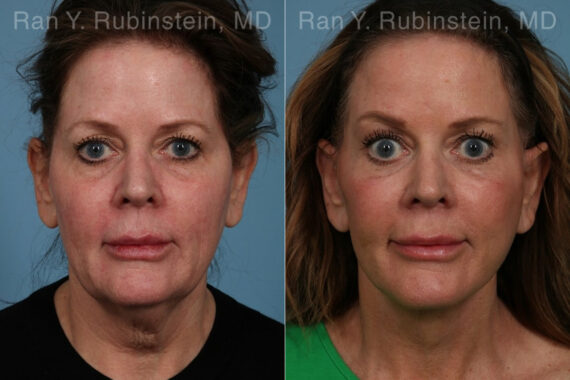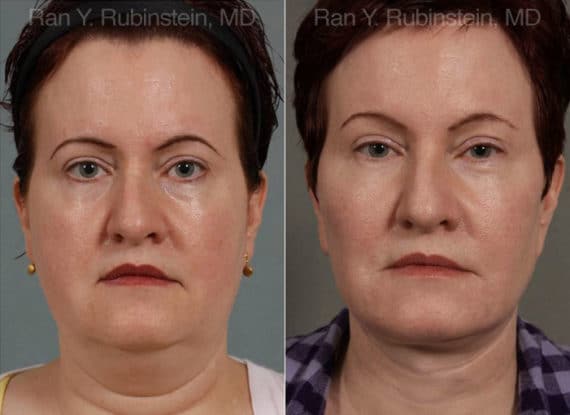Rapid weight loss should feel like an incredible achievement. Whether you’ve shed pounds through consistent diet and exercise or with the help of GLP-1 medications like Ozempic, the health benefits and newfound confidence are worth celebrating. But there can also be an unexpected downside: dramatic changes to your face. Many weight loss patients notice sagging skin, hollowed cheeks, or deepened wrinkles, particularly in the lower face and neck. If you’re wondering whether plastic surgery weight loss procedures might help, you’re not alone.
One of the most common questions we hear from weight loss patients at Rubinstein Plastic Surgery Center is: “How soon is too soon for a facelift after weight loss?” Timing is everything when it comes to plastic surgery. Rushing into a procedure too early could impact your results, while waiting too long might prolong your discomfort. In this guide, we’ll explore what to expect from your facial appearance after weight loss and how to plan facelift surgery for the best possible outcome.

What to Know Before Choosing a Facelift After Weight Loss
- Massive weight loss can cause the face and neck to appear aged or sagging due to fat loss and loose skin.
- A facelift, especially a deep plane facelift, can restore definition and lift the lower face.
- Timing is crucial: waiting until your weight stabilizes ensures more lasting, natural-looking results.
- Getting a facelift too soon can increase the risk of poor results or needing revision surgery.
- Consulting with a board-certified facial plastic surgeon like Dr. Rubinstein helps ensure your procedure is safe, personalized, and effective.
Ozempic Face: Facial Changes Following Weight Loss
Losing a significant amount of weight doesn’t just impact your body—it often transforms your face too. When facial fat disappears quickly, as it often does with GLP-1 medications like Ozempic, it can leave behind loose skin, deep folds, and hollowed-out features. This change in facial proportions is sometimes referred to as “Ozempic face.”
The effects are especially visible around the cheeks, jawline, and neck. Without the underlying fat to support them, these areas can sag, making you look older or tired, even if you feel healthier than ever. Unfortunately, no amount of exercise or skincare can fully restore volume and lift to the face once the underlying structure has shifted. That’s when surgical facial rejuvenation procedures like a facelift or neck lift come into play.
How a Facelift Surgery Can Help
Facelift surgery is one of the most effective ways to reverse the visible signs of facial aging after weight loss. Unlike non-surgical treatments that offer subtle improvements, facelift procedures reposition and tighten the deeper layers of the face and neck. This not only lifts sagging skin but also restores youthful contours that may have been lost during your weight loss journey.
At Rubinstein Plastic Surgery Center, Dr. Ran Rubinstein often performs the deep plane facelift—a technique known for its natural, long-lasting results. Rather than just pulling the skin tight as with a traditional facelift, this approach lifts the underlying muscle and fat layers to reposition the entire face more effectively. This is especially beneficial for patients dealing with significant facial fat loss, loose neck skin, and jowling.
Key Factors to Consider Before Getting a Facelift After Weight Loss
If you’re thinking about plastic surgery after weight loss, timing is key. Here are some important considerations to help you decide when to move forward:

Age
Younger patients tend to have better skin elasticity, which can improve healing and results. However, excellent results are still possible at older ages with the right procedure and expert care.
Overall Health and Well-Being
Plastic surgery is safest and most effective when you’re in good health. Chronic conditions like diabetes or high blood pressure should be well-managed before moving forward with any facial plastic surgery.
Stability of Weight Loss
Perhaps the most critical factor is ensuring that your weight has stabilized. Most surgeons recommend waiting at least 6 months to a year after your goal weight is reached. If your weight continues to fluctuate, it can affect the results of your facelift and increase the likelihood of needing a second procedure.
Patient Results
* All patients are unique and individual results may vary.
Benefits of Getting a Facelift at the Right Time
When facelift surgery is timed correctly after weight loss, the benefits can be dramatic and long-lasting. Here’s what you can expect:
Improved Skin Tightening
Waiting until the skin has fully retracted allows your surgeon to see exactly how much excess skin needs to be removed or repositioned. This improves the precision of the lift.
Better Results
When your weight is stable and your facial tissues have settled, it’s easier to achieve smoother, more natural-looking contours. You won’t have to worry about future weight changes disrupting your results.
Improved Confidence
Facial aging after weight loss can be discouraging. A facelift can restore facial harmony and help you feel as confident in your appearance as you do about your health journey.
Reduced Risk of Complications
Operating on a face that is still changing increases the risk of complications and revision surgery. By waiting until your weight stabilizes, you minimize these risks and increase the chance of a successful outcome.
Risks of Getting Facial Plastic Surgery Too Soon After Weight Loss
Some patients are understandably eager to refresh their facial appearance after weight loss. But moving forward with surgery too soon can lead to avoidable setbacks:
Possibility of Needing a Second Procedure
If your skin continues to retract or you lose additional weight after surgery, you may find yourself needing a second lift to maintain your results.
Skin May Not Have Fully Retracted Yet
The skin often takes months to adjust to your new facial volume. If surgery is done too early, your surgeon may not be able to accurately assess how much skin to remove or reposition.
Potential Disappointment with Results
Premature surgery can lead to underwhelming or uneven results that don’t meet your expectations. This can be emotionally discouraging and financially costly if revision is required.
Not sure if you’re ready yet?
That’s exactly what a consultation is for. Dr. Rubinstein will guide you based on your unique facial structure and weight history.
Ideal Timing for a Facelift After Weight Loss
So, when is the right time to consider facelift surgery after weight loss? Most facial plastic surgeons recommend waiting 6 to 12 months after reaching your goal weight. This allows time for your skin to retract naturally and your facial fat distribution to settle.
It’s also important to evaluate whether your weight loss is complete or ongoing. If you’re still using Ozempic or another GLP-1 medication, discuss your long-term goals with your surgeon before scheduling a procedure.
Ultimately, the best way to determine the right timing is to consult with an experienced facial plastic surgeon. Dr. Ran Rubinstein is a double board-certified facial plastic and reconstructive surgeon with extensive experience helping patients navigate post-weight loss facial rejuvenation.
Why Choose Dr. Rubinstein?
With over two decades of experience, Dr. Ran Rubinstein is a leader in advanced facial plastic surgery techniques, including deep plane facelifts, neck lifts, and eyelid surgery. He understands the unique challenges that weight loss patients face and works closely with each patient to design a personalized treatment plan.
At Rubinstein Plastic Surgery Center, you’ll receive expert care in a state-of-the-art facility with a supportive team that prioritizes your safety, satisfaction, and results. Whether you’re considering a mini facelift, deep plane lift, or full facial rejuvenation, Dr. Rubinstein can help you time your procedure for long-lasting improvement.
Ready to take the next step in your transformation? Schedule your facelift consultation with Dr. Rubinstein today and learn how facial plastic surgery can help you look as good as you feel. Don’t wait to reclaim your confidence—book a consultation today and find out if now is the right time for plastic surgery weight loss treatment tailored just for you.
FAQs about Facelift after Weight Loss
Non-surgical treatments like dermal fillers, skin tightening devices, and laser resurfacing can provide temporary improvements in facial appearance. These treatments are best for patients with mild to moderate volume loss or early signs of aging. However, they can’t achieve the same level of lifting or tightening as a facelift. For more significant changes due to massive weight loss, surgical procedures often offer the best results.
Losing additional weight after facelift surgery can impact your results, especially if the weight loss is substantial. Facial fat volume may continue to decline, and skin can become looser, reducing the effectiveness of your initial lift. That’s why surgeons recommend waiting until your weight has stabilized for at least 6 to 12 months before considering facial plastic surgery.
Facelift results can last 10 years or more, depending on factors like age, skin quality, and lifestyle habits. For patients who have undergone significant weight loss, results may last longer if the procedure is performed at the right time and paired with ongoing skin care and a healthy lifestyle. Choosing an experienced plastic surgeon like Dr. Rubinstein is key to maximizing the longevity of your results.



